Marketing Strategies
How to Set Up Ad Retargeting on Facebook
In college, I took an advertising class. It was helpful in teaching me what I needed to know about traditional advertising, but the social media portion wasn’t as expansive.
When we covered Facebook Advertising, for example, I found it difficult to follow along with a lack of examples and the lofty overview of content. Because of that, I decided to look online for a deeper take on the subject.
I ended up watching a video that taught me the basics, and one that covered a subject I’d struggled with in class — retargeting.
The video first gave an overview of audience retargeting. Then, it went into depth about how that looks on Facebook with vibrant examples, really helping a visual learner like me.
I loved that I was able to watch a short, yet impactful video on my own time and learn what I needed to fill in the gaps of what I knew about retargeting, and how it works. Retargeting helps re-engage customers you lost, and one method to do that is with social media, like Facebook.
If you’ve never used retargeting before, don’t worry — in the following post, we’ll go through the basics of how retargeting works, explain how you can use it to support your larger marketing goals, and even outline an example of a Facebook Ad retargeting campaign.
How Retargeting Campaigns Work
There are two main types of retargeting: pixel-based and list-based. The way each works is slightly different, and each has different advantages based on your campaign goals.
Pixel-Based Retargeting
Pixel-based retargeting is a way to re-display your material to any anonymous site visitor.
This is probably the most common type of retargeting. When someone comes to your website, an unobtrusive piece of JavaScript (often referred to as a pixel) is placed on their browser — making their browser “cookie-d.” When they leave your site to surf the web, that cookie notifies retargeting platforms to serve specific ads based on the specific pages they visited on your website.
The advantage of pixel-based retargeting is that it is timely (they can be retargeted pretty immediately after leaving your site), specific to a particular page on your site, and behavior-based. Downsides to this method are that there is a lower volume of people in the campaign at any given moment in time since it’s all based on how often people are coming to your website, viewing certain pages, and leaving. It also can be complicated or time-intensive to implement the JavaScript on many website pages.
List-Based Retargeting
List-based retargeting works after you already have someone’s contact information in your database.
You can also use lists of your existing contacts for certain types of retargeting ads. To do this, upload a list of the email addresses to a retargeting campaign (usually on a social network like Facebook or Twitter), and the platform will identify users on that network who have those addresses and serve retargeting ads just to them.
Though it’s a little less common than pixel-based retargeting, list-based retargeting allows you to have highly customizable criteria for your ads because it’s based on more than behavior — you’re choosing who goes in which list.
On the flip side, it’s possible that a person in your list gave you one email address and the social network another — and in that case, they won’t see your ads. Also keep in mind that because you are in charge of uploading and maintaining the list, list-based retargeting also is less automatic and timely than pixel-based retargeting.
If you’ve ever heard of the term “retargeting,” it’s likely it was in comparison to remarketing. And while the two are often mistaken for each other, they do have differences. Let’s talk about when you would use either.
Remarketing and retargeting are often confused with each other. Though they share similarities, retargeting allows you to reach new prospects with your ads, while remarketing focuses on re-sparking interest of your company to current or inactive old customers.
A retargeted ad helps those who’ve never heard of your company understand how your product or service fits into their lifestyle or solves a potential problem. Retargeting helps you make the message more personal.
When you analyze sales, you can determine what’s popular among the audiences you’re aiming to reach. For instance, if you find that a certain line of products perform really well among millennials, pull images of them into a carousel ad and use it to retarget customers. The personalization of a separate ad promoting a collection, aimed at a segment of your target market, is one example of how retargeting can be successful.
Take this ad I saw today. Despite never having purchased from Nasty Gal, this ad showed up on my News Feed:
This ad introduces Nasty Gal to new leads (like me) by giving an overview of diverse clothes that are popular among target audiences.
It’s likely I saw this ad because I fit into Nasty Gal’s target audience set on Facebook, and because my previous behavior on the social channel involved looking for reviews of similar clothing retailers.
On the other hand, to re-engage a lost or inactive customer, you might decide to use remarketing. This tactic aims to improve customer relationships by utilizing marketing tactics that
Essentially, if you want to give customers an incentive to purchase again from your company, turn to remarketing.
For customers that are already acquainted with your brand and have shown a need for your product, create a personalized message to reignite their interest. For example, if your company offers a membership, remarket to those whose memberships are expiring and are up for renewal. This email I received is an example:
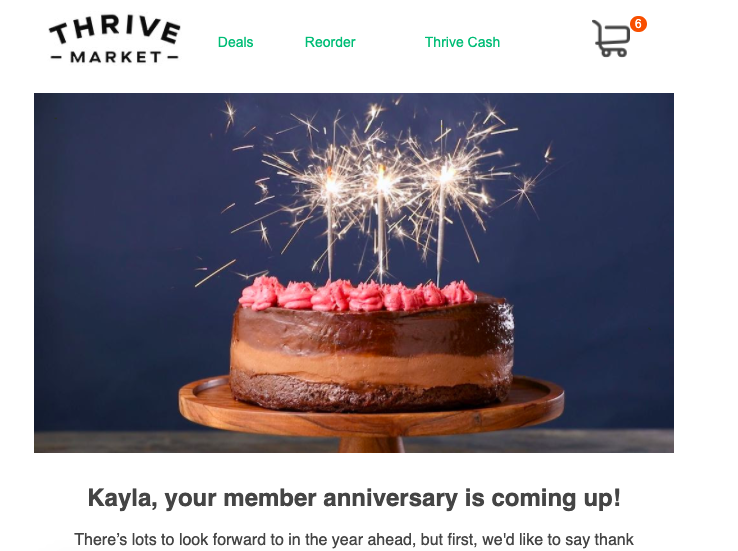
This marketing email not only served as a reminder to renew my subscription but was also Thrive Market‘s way of reminding me about the benefits of being a member. In the email, I got to see how much I saved by using the grocery service, where my membership money was being spent, and was offered a special promotion to renew.
Because I was already familiar with the brand, Thrive was able to use the email to add personal touches and provide a snapshot of what I can enjoy (again) as a member.
Like retargeting, this tactic is successful when messages inspire action. The email’s CTAs, like “Browse our options here!” told me that I could peruse my options in one click, so I did. Use remarketing efforts to remind customers of the perks that come with shopping with your brand, like easy shopping access.
Which Goals You Should Have for Retargeting
Now that we have the background for how retargeting works and the different types of audiences you can segment by, we can focus on goals. The main types of retargeting campaigns you should consider running are those for awareness and those for conversion.
Awareness
Awareness campaigns are useful when you want to re-engage website visitors and tell them about relevant products, features, or announcements. These ads are usually served to pixel-based lists.
The obvious drawback to awareness campaigns is that you’re serving less targeted content to people who haven’t engaged heavily with your brand. They’re not in your contacts database, and often, there are lower expected clickthrough rates than other types of campaigns.
However, since the goal is to make prospects aware of your business, impressions and engagement are acceptable metrics to track. Often awareness campaigns are precursors to a much more effective campaign goal: conversions.
Conversion
Conversion goals are just that — you want to get people to click on your ad and take a next step, such as filling out a landing page form. Conversion campaigns are best used to align a specific list with a clear next step in the flywheel, and can be measured with typical conversion metrics like website clicks, form submission, and cost-per-lead (CPL).
The best thing about a conversion campaign is that you can use it for multiple parts of the flywheel. Pixel-based ads, for instance, generate leads and will direct people to landing pages where they can give over their information.
List-based ads better qualify those leads. Ads will appear to contacts who gave you limited information and lead them to longer forms with additional fields.
Additionally, retargeting can be used to move those qualified leads further along their sales cycle. For example, you might use retargeting to send a list of contacts that have downloaded an ebook to sign up for a free trial of your product.
Regardless of your goal, it is important to align the positioning, creative, and next step in the conversion process — whether that’s an offer landing page, site page, or request for more information — with your audience list. List-based retargeting can have low match rates (users synced with accounts on each platform, usually by email address), so make sure you’re fueling your retargeting activities with inbound content.
Choosing a Retargeting Platform and Tool
Truthfully, you’ve got quite a few options for actually implementing your retargeting. There are tons of third-party platforms to do web and social retargeting, such as Perfect Audience, AdRoll, Retargeter, and Bizo. You can also do retargeting through specific platforms like Facebook, Twitter, and LinkedIn.
While email targeting can be effective, it’s important to note many of the other platforms that could also be beneficial.Although each platform you use to implement ads will be different, there are some advantages and disadvantages for choosing ones that serve up social media ads or elsewhere on the web.
Social media retargeting often works well since people are more likely to share, reply, and discuss your content on one of these well-known platforms. They can also see the ads are posted from a real account, as opposed to a small web banner ad with little text that could be posted by anyone. That being said, web retargeting works well for impressions since the ads follow your targeted audience throughout the internet, not just on a few specific social media sites.
Want to see how setting up a remarketing campaign is like? We’ll walk through a step-by-step process on setting up a retargeting campaign and measuring its success.
Facebook Retargeting
Facebook retargeting is no different from the other types of retargeting we’ve talked about — It helps you advertise to potential customers and lost leads. Facebook’s technology leverages data from different profiles to help you connect with the right audience. Data, like web behavior, is used to show your ads on the right news feeds.
On Facebook, you have the advantage of its large audience. Coupled with the amount of data Facebook collects about its users, it’s highly likely that the leads you lost are seeing your ad. The website looks at the previous search history of users and pulls ads that are relevant.
For example, every time I online shop for clothes and leave the site without making a purchase, the ads I see on Facebook are from the store I’d visited. If I were to use the search bar on the social media network, I would see similar results.
To run a retargeting campaign on Facebook, you’ll set an ad campaign and choose your audience set — just like a regular campaign. The difference is this: In Ad Manager, you’ll toggle a switch that tells the website that the campaign is a retargeting one. That way, the software will know how to filter the right target market for your ad.
For this example, we’ll pretend we’re setting up a remarketing campaign for HubSpot. To drive qualified leads to a free trial, we’ll set up a mock Facebook retargeting campaign for leads in our database who we know are interested in marketing automation. Here’s how we would set up that campaign.
1. Create a list or existing contacts, or gather groups from pixel on your website.
First, you’d need a list of leads to retarget to. In your marketing software of choice, compile a list based on two criteria: lifecycle stage, interests based on the topic of their most recent download. If this list is sufficiently large, you can move on to the next step. If it’s not, you should revisit your segmentation properties and/or type of retargeting to implement.
2. Uploading the list to Facebook’s Audience Manager.
Once our list is processed, we can export the .CSV file and import it into Facebook’s Custom Audience manager to match email addresses with Facebook Profiles. (There are third-party platforms that also sync these lists on social media, so feel free to pick which upload/sync option works best for your company.)
Aside from Facebook retargeting, Audience Manager will allow you to do standard targeting, which allows you to set demographic, geographic, and other audience targets for an ad — even without a retargeting list.
Once you hit “Manage Your Ads” on Facebook’s advertising home page, click “Audiences” on the left toolbar. This will allow you to create a customer list by uploading a .CSV or .TXT file and options to sort by user ID, phone numbers, or emails.
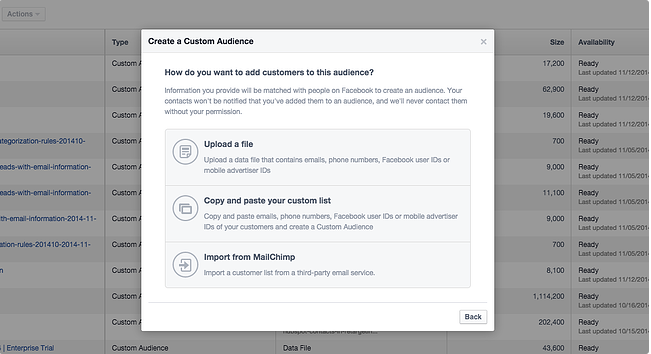 Give your list an appropriate name to easily find it later. Additionally, leave at least a few hours for it to populate. if you try to create an ad immediately, the audience may not be fully loaded.
Give your list an appropriate name to easily find it later. Additionally, leave at least a few hours for it to populate. if you try to create an ad immediately, the audience may not be fully loaded.
3. Determine your destination URL.
To create a new campaign on Facebook, hit the green “Create Ad” button in the top right of the ad platform home screen. This will prompt you to choose an objective for your campaign. Whatever option you select, include a UTM tracking code — a snippet of text added to the end of your URL — to help you track success and attribute clicks and conversions from your campaigns. For example, we would create a campaign called “Retargeting” and our URL for the free trial would look like:

http://offers.hubspotm/free-trial?utm_campaign=retargeting&utm_medium=social&utm_source=facebook
Once you enter your URL to promote, the next step is to rename your campaign directly underneath the URL text box. Keep similar names for your campaigns to make it easier to track if you have multiple running.
4. Segment your ads.
Select your custom audience and set the geographic location you want to target. The location is an “AND” setting, meaning if your list contains leads from all over the world and you only select “United States,” some people won’t be shown your ads.
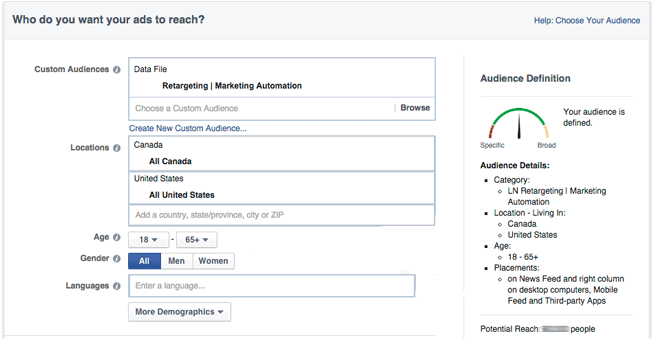 Depending on your buyer personas, you can also segment by interest, behaviors, age, and other demographic settings which can help ads become even more targeted. For conversion campaigns, you’re retargeting to a specific list of contacts already interested in your product, so including other Facebook categories might not make sense.
Depending on your buyer personas, you can also segment by interest, behaviors, age, and other demographic settings which can help ads become even more targeted. For conversion campaigns, you’re retargeting to a specific list of contacts already interested in your product, so including other Facebook categories might not make sense.
5. Set your budget.
Before even starting the campaign, have a set budget for paid tactics, broken out by channel. For Facebook campaigns, set a lifetime budget for the length of the campaign, then monitor and adjust accordingly. Most beginners should leave the bidding to “Optimize for Website Click.”
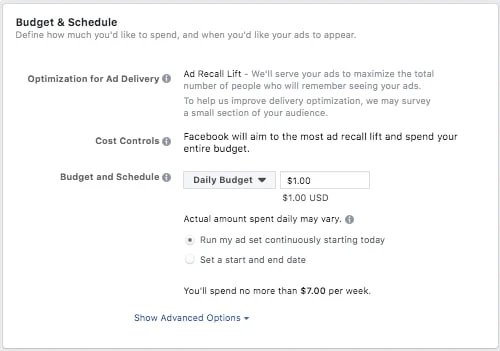 You can also name your ad set at this stage, which is helpful if you’d like to differentiate lists, creative, budget, etc. for different ad sets in the same campaign (i.e. leading to the same page).
You can also name your ad set at this stage, which is helpful if you’d like to differentiate lists, creative, budget, etc. for different ad sets in the same campaign (i.e. leading to the same page).
6. Creating your ad.
Each ad can have up to six images associated with it, so you can test which ones perform the best. Be clear and concise with your positioning as the headline underneath the image can only be 25 characters long and the text above the image is capped at 90 characters. You can also include call-to-action buttons such as Shop Now, Learn more, Download, etc. on the bottom right of the ad.
Some important details on Facebook ads:
- Image size is 1080 x 2020 pixels.
- Images can only contain 20% text.
- Under “Advanced Options” you can write a News Feed link description up to 200 characters to better explain your ad.
By default, ads are shown on mobile newsfeeds, on the right column on desktops, and in partner mobile apps. Depending on where you’d like your customers to see these campaigns, you may want to turn one or all of those options off to only display in the desktop News Feed.
Once you have everything set up, go ahead and click the green “Place Order” button in the bottom right of the screen.
7. Tracking your progress.
Congratulations, you’ve now created a conversion-based retargeting ad on Facebook! Now you can track website clicks, reach, CTR, CPC, and total spend to match them up to your initial goals.
You can get a glance of how your Facebook retargeting campaigns are doing by going to your Facebook Advertising home page. If you want to dive further into the ad’s metrics, you can go into the ad set where you’ll see information like clicks and spending per day. It is also easy to make edits to your ad from this screen, such as extending the budget, schedule, and creative assets.
If you’re using a CRM, like HubSpot, most offer tools to look at the performance of your destination URL to track views, clicks, and submissions back to specific retargeting campaigns.
Retargeting is a great way to keep your prospects engaged and interact with people who have already shown interest in your company.
While it may sound like a simple enough concept, there are many aspects of a retargeting campaign that must be worked out before you make the ad copy and creative. Be sure to give enough time to make your lists, set goals and types of campaigns, determine the platforms your ads will run on, and tie the whole conversion path together.
Marketing Strategies
OpsStars Virtual Event Preview: Q&A With Rachael McBrearty, Chief Customer Office At LeanData
/
Now in its fifth year, OpsStars has grown into a must-attend event operations and revenue-focused executives turn to for targeted education and networking./
Demand Gen Report caught up with Rachael McBrearty, one of the LeanData executives shaping the agenda for the event, to get a preview of what attendees can expect during the virtual event on October 20-21—including presentations from high-growth B2B brands Zoom and Docusign.
Demand Gen Report: RevOps was the hot topic at OpsStars last year. How does RevOps fit into LeanData’s vision today?
McBrearty: Last year at OpsStars, we were really proud to spotlight Revenue Operations as an important new operating model for growth in B2B – and the role operations will play in enabling it. Much of our agenda centered around “The Journey to RevOps” as the event’s topline theme.
Fast forward nearly one year, and we’re seeing even greater momentum behind the RevOps movement. The COVID-19 pandemic drove a greater imperative for sales and marketing leaders to improve go-to-market alignment to support growth in a challenging economy. We’ve also seen RevOps expand further into the enterprise. Management consulting firms like Boston Consulting Group have even launched cross-practice initiatives around RevOps to support some of the world’s biggest companies in moving to this model.
Working with our customers, we spotted the RevOps trend early on – even before it had a name! From this vantage point, we strongly believe RevOps will become the dominant operating model for driving predictable, efficient revenue growth in B2B.
DGR: “The Rise of Ops” – what’s the meaning behind your OpsStars 2020 theme?
McBrearty: This year we wanted to shine a spotlight on operations professionals themselves – and the increasingly strategic role they play in the revenue process.
Ops is really the backbone of go-to-market strategy and execution – and ultimately revenue growth.
Even more so in recent years, as this role supports increasingly sophisticated and complex sales and marketing strategies and programs. Yet Ops still operates largely behind the scenes.
We see this changing, however, as Ops play a more visible role and increasingly takes a seat at the table. This year’s OpsStars will recognize “the rise of ops” and their role as superheroes of the modern revenue engine.
DGR: Can you tell our audience more about the “virtual” experience planned for OpsStars attendees this year?
McBrearty: Virtual events are new for everyone this year – we’re all learning as we go! However, we put a great deal of thought into the best way to structure OpsStars in this new format.
Networking is one of the key reasons people attend OpsStars, so we wanted our attendees to come together as much as possible in a virtual setting. For example, although the event is held across two days, we’ve limited each day to four hours to make it easier for people to carve out time to attend and participate without distraction. We also have a number of workshops to bring people together, and we’ll set up a Slack channel to encourage conversations around key topics amongst attendees, presenters and sponsors.
Now in its fifth year, OpsStars has always been an event “by Ops, for Ops.” Through a virtual platform, we aim to continue our tradition of bringing together sales, marketing, customer and revenue operations leaders to share best practices, career development and networking.
DGR: Lead management seems prominent on the OpsStars 2020 agenda. Has that expanded from last year?
McBrearty: Yes, we’re so fortunate to have the ops teams from Zoom and DocuSign giving attendees a peek under the covers at how their teams successfully managed unprecedented spikes in demand nearly overnight due to the COVID-19 pandemic. Both for Zoom and DocuSign, their ability to scale lead management to keep up with this level of demand was critical to powering their rapid response to incoming requests.
Nearly all companies were impacted by COVID, however, and automated lead management is essential to helping them pivot to go-to-market in days, or even hours, as business conditions change. This level of agility has become critical for business continuity and execution in these uncertain times.
DGR: Lead-to-Account Matching & Routing recently became an “official” martech category. This is great validation for LeanData. What do you think it says about the future growth of the category.
McBrearty: Yes, this was a major milestone for our company! TOPO (now part of Gartner) released the first in-depth Market Guide for Lead-to-Account Matching and Routing in August. Up to now, this technology has been somewhat of a “best-kept secret,” with B2B adoption estimated at 48 percent. However, TOPO says it is now one of the most critical applications in the tech stacks of modern sales and marketing organizations. We were gratified to see TOPO named LeanData the dominant vendor in this space.
This is no fledging tech category – it’s been in the works for the better part of a decade. But TOPO’s report is a significant validation of what we and our customers have worked hard to create. We believe formalizing Lead-to-Account Matching and Routing as an “official” tech category, with de facto standards and best practices, will create more awareness around the technology and make it easier for more companies to adopt.
Marketing Strategies
How to adapt your SEO strategy to navigate through the pandemic
30-second summary:
- When you’re starting with your adapted SEO strategy, it’s important to acknowledge the changes in your working environment. All remote teams need to evaluate their communication needs to improve their efficiency in the ‘new normal’.
- You don’t want more unfortunate surprises during turbulent times. Meaningful reporting can connect content, SEO, marketing, and web activities to give everyone the visibility to plan for future projects.
- The idea is to reduce unnecessary meetings to empower your team to work on their own. Start by communicating your SEO strategy and what everyone will work on.
- One of the first changes should be to look at your website and your content to make it more relevant. Explain how COVID-19 is affecting your businesses and how you’re still supporting your clients.
Right after the initial shock of the pandemic, many businesses are reassessing their strategies to remain successful. Organic search can help you set up a successful SEO strategy to support your business’s recovery.
Conductor has written a post-pandemic SEO strategy playbook with practical tips to explore business opportunities through organic search.
Content created in partnership with Conductor.
The power of SEO during COVID-19
As we are all spending more time at home, Google searches are increasing. There is an estimate of 20 billion searches every day.
This is a great opportunity for businesses to capitalize search traffic to increase sales.
What’s more, SEO is a low-cost and very effective method to increase your brand awareness before you increase your ad spend.
What’s important though is to understand how COVID-19 has affected SEO and how to adjust your strategy.
Defining your remote communication style
When you’re starting with your adapted SEO strategy, it’s important to acknowledge the changes in your working environment. All remote teams need to evaluate their communication needs to improve their efficiency in the ‘new normal’.
Start with internal communications and the tools that will get your team more productive. Foster an environment of transparency and accountability and document the team’s workflows.
Improved visibility can help you prioritize the crucial tasks that you need to focus on. Moreover, the more transparent you are, the easier it becomes to collaborate with different departments towards shared objectives.
Conductor recommends the use of surveys to gather feedback about your website, your marketing campaign or even for content ideas. It’s a great way to plan for short and long-term projects while getting perspective from various teams.
All the findings can help you set up your communication style, how you’re interacting as a team and how you can be more productive.
Create meaningful reporting
You don’t want more unfortunate surprises during turbulent times. Meaningful reporting can connect content, SEO, marketing, and web activities to give everyone the visibility to plan for future projects.
It’s not enough to create reports that nobody is interested in reading. It’s time to build digestible reports that your stakeholders would appreciate.
There are many things that you can measure to support your SEO strategy. You can also work alongside different teams to discover interesting insights that can lead to multiple wins.
For example, working with the sales team can help you spot opportunities to appeal to potential customers. Search insights can help you create the right content while providing valuable data to your salespeople.
Keep in mind, your executives should include what your stakeholders want to see. It’s important to align your tactics with the key factors that will affect your business success, such as traffic, revenue, retention, etc.
Looking for creative reporting? The Conductor team is recommending the use of a five-minute video that can replace a time-consuming report.
Use it to describe your team’s performance and what you’re planning to do next.
Train your team to be self-sufficient
The best way to maintain your productivity in a remote environment is to train your team to be self-efficient. If there are many similar questions from your team, how about creating a report answering these questions?
The idea is to reduce unnecessary meetings to empower your team to work on their own. Start by communicating your SEO strategy and what everyone will work on.
Encourage your team to share their ideas and work on an action plan that will get the most of every team member.
Identify high priority changes
This is the best time to focus on what matters. Work with your team and your key stakeholders to define your priorities and how to spend more time on them.
It’s important to communicate all the changes with your customers to keep them up-to-date with what’s happening.
Start by answering the question:
What do customers want to know about my business and any recent changes related to COVID-19?
The answer can help you work on your internal and external communication to give everyone more clarity on what’s coming up.
One of the first changes should be to look at your website and your content to make it more relevant. Explain how COVID-19 is affecting your businesses and how you’re still supporting your clients.
Look at your current SEO strategy and adjust the keywords and content plan, if needed.
Review your online profiles and business listing to keep all relevant details up-to-date.
For example, ecommerce companies should update all the information around delivery details, product availability and potential offers.
If you are changing your working hours or your business focus, make sure you communicate the changes with your customers.
There’s no over-communication during a crisis.
Looking at the bigger picture
It’s not just about surviving the current situation. Your business should also look at the bigger picture of what’s coming up next.
It’s the best opportunity now for planning, reflection, and collaboration.
If you’re using Conductor, look at your workflows to understand the impact of the crisis in your visibility. Adjust your plans accordingly, if needed.
Stay on top of change with regular monitoring and use your SEO strategy to maintain long-term success for your business.
Ready to explore practical tips to improve your SEO strategy post-pandemic? Download Conductor’s SEO strategy playbook for additional ideas and templates.
The post How to adapt your SEO strategy to navigate through the pandemic appeared first on ClickZ.
Marketing Strategies
Why behavior analysis is important online business
30-second summary:
- A typical consumer now owns an average of 3.6 devices which means a person’s journey may start from a laptop and end on a mobile or a tablet.
- In the ecommerce business, the cart abandonment rate is the thing that haunts most of the business owners.
- Developing analytical skills can help you better manage these obstacles.
- MD of SEO Discovery shares a guide to help you understand Cohort Analysis and Behavior Analysis to eliminate roadblocks and improve engagement.
In today’s digital age, the customer journey is getting complex day by day and if you are doing online business then it’s vital to understand your customer journey. A typical consumer now owns an average of 3.6 devices which means a person’s journey may start from a laptop and end on a mobile or a tablet.
In the ecommerce business, the cart abandonment rate is the thing that haunts most of the business owners. According to Statista, 88.05 percent of online shopping orders were abandoned in March 2020 worldwide, which means over 88% of people added selected products into the cart and left without buying for various reasons. This is a massive business opportunity loss for ecommerce players.
Developing analytical skills can help you better manage these obstacles. Without adequate knowledge of analytics, your marketing won’t work because you won’t know what worked and what didn’t work. All the marketing suits come with analytics tools to help perceive the behavior, engagement metrics, and demographics of the visitors coming to a website. The most common web analytics tools are Google Analytics, Adobe Analytics, Kiss Metrics, and Mixpanel. They generally come with the following features and capabilities:
- Real-time analytics
- Mobile analytics
- Attribution modeling
- Segmentation
- Ecommerce tracking
- Funnel analysis
- Cohort analysis
- Cross-device tracking
- In-page analytics (Session recording, click tracking, heatmaps)
- Goal conversion tracking
- Event tracking
- A/B testing
Every feature has its own data sets which can be compared to help you make informed decisions. Today we are going to understand Cohort Analysis and Behavior Analysis to eliminate roadblocks and improve engagement.
What is a Cohort Analysis and why is it important?
Cohort analysis is a subset of users grouped by shared characteristics. It simply allows you to compare the behavior and metrics of different cohorts over time.
Cohort Analysis Example - Finding Engagement Drop
Let’s suppose you have an online food ordering website/app and using acquisition date (when users started their first sessions) cohorts you can find out when in the customer lifecycle your users tend to drop off.
The best way for visualizing this data is to chart out the retention curve, portraying retention over time.
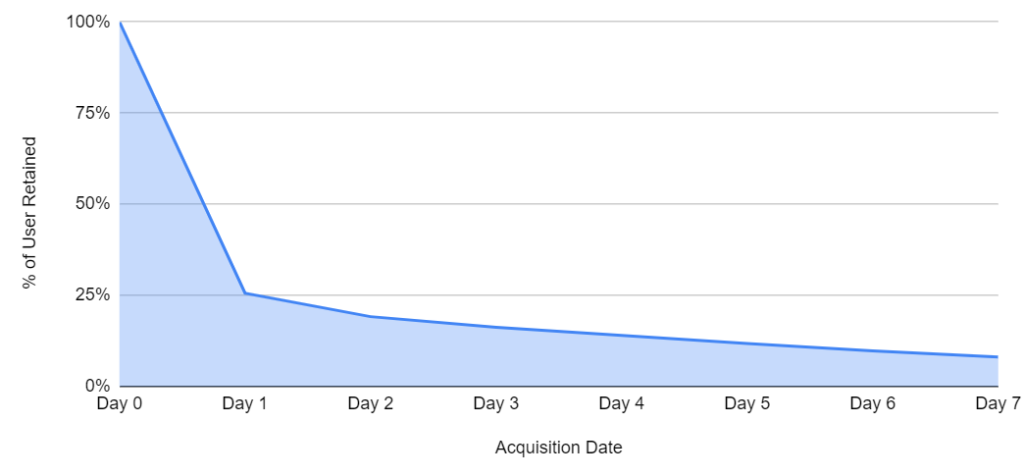
This retention curve clearly reflects the most important insight – around 75% of the users stop using the website after the first day. We can see a downfall in the engagement. Hence, it’s evident to improve the overall experience and abet customers through daily offers/coupons to boosting retention.
Cohort Analysis Comparison - Organic vs Direct
The below cohort analysis indicates that organic traffic has a better retention rate than direct.
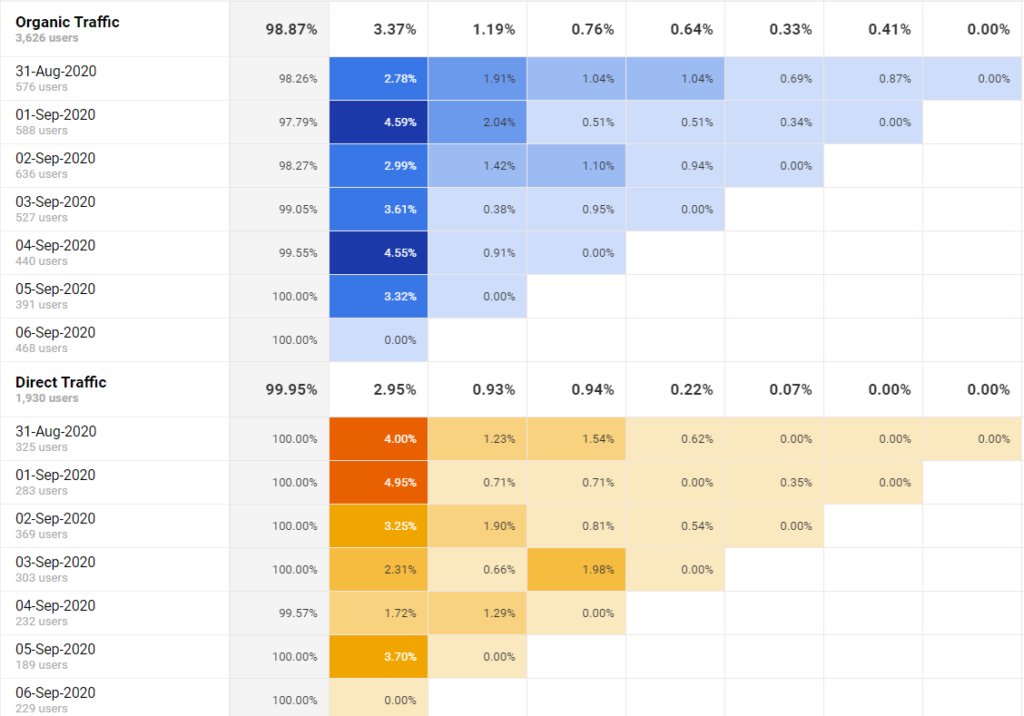
Visitor behavior analysis and its importance
It’s a process of tracking user behavior on a website and there are some great tools in the market that give accurate information. Tools like Hotjar, MouseFlow, Crazy Egg record visitor sessions to see how visitors are navigating on the website. They also offer click tracking and heatmaps to analyze the most engaging and ignored (skipped) elements on a page.
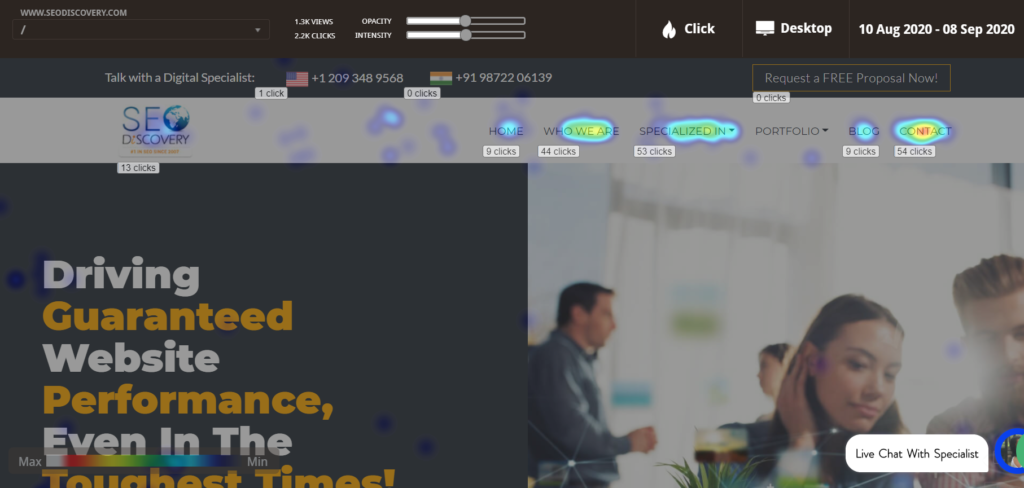
If you look at the above heatmap, you would notice that no one bothered to click on “PORTFOLIO” in the top menu, which means people aren’t interested in see the portfolio. Maybe we have to replace it with something more interesting (like Case Studies, Achievements, and more) which grabs a visitor’s attention. These kinds of insights help you add/remove elements to improve page engagement.
Using filters, you can further segment your audience to dig deep and pull out actionable insights, see those filter below:
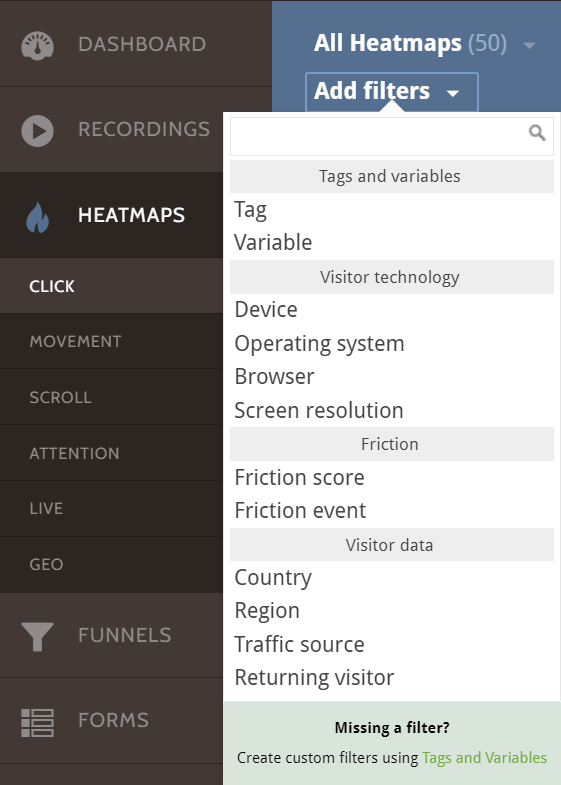
In Google Analytics, behavior flow gives you a visual presentation of how people are navigating on your website. You can apply segments to get a deeper view of their behavior and it also enables you to apply different dimensions on top of these segments to get actionable insights.
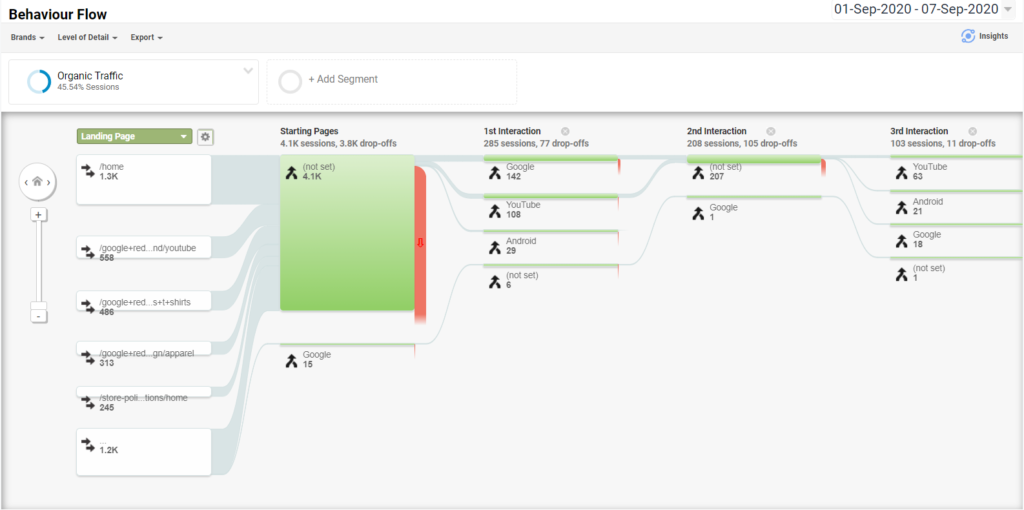
The power of these analytical tools lies in the fact that it allows you to view which customers leave and what’s making them leave your website/app – so that you can fix it. You can also hire a professional digital marketing agency that can help you find these hurdles and remove them to enhance your overall engagement.
Mandeep Singh is the MD of SEO Discovery. He’s mission is to provide affordable digital marketing services to startups and SMEs. He’s an official member of Forbes Agency Council. You can find him on LinkedIn.
The post Why behavior analysis is important online business appeared first on Search Engine Watch.
-
 Business2 months ago
Business2 months agoBernice King, Ava DuVernay reflect on the legacy of John Lewis
-
World News2 months ago
Heavy rain threatens flood-weary Japan, Korean Peninsula
-
 Technology2 months ago
Technology2 months agoEverything New On Netflix This Weekend: July 25, 2020
-
Finance4 months ago
Will Equal Weighted Index Funds Outperform Their Benchmark Indexes?
-
Marketing Strategies9 months ago
Top 20 Workers’ Compensation Law Blogs & Websites To Follow in 2020
-
 World News8 months ago
World News8 months agoThe West Blames the Wuhan Coronavirus on China’s Love of Eating Wild Animals. The Truth Is More Complex
-
Economy11 months ago
Newsletter: Jobs, Consumers and Wages
-
 Finance10 months ago
Finance10 months ago$95 Grocery Budget + Weekly Menu Plan for 8

